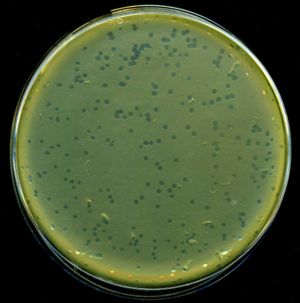
Phage typing
Encyclopedia

Strain (biology)
In biology, a strain is a low-level taxonomic rank used in three related ways.-Microbiology and virology:A strain is a genetic variant or subtype of a micro-organism . For example, a "flu strain" is a certain biological form of the influenza or "flu" virus...
of bacteria
Bacteria
Bacteria are a large domain of prokaryotic microorganisms. Typically a few micrometres in length, bacteria have a wide range of shapes, ranging from spheres to rods and spirals...
. It is used to trace the source of outbreaks of infections. The virus
Virus
A virus is a small infectious agent that can replicate only inside the living cells of organisms. Viruses infect all types of organisms, from animals and plants to bacteria and archaea...
es that infect bacteria are called bacteriophage
Bacteriophage
A bacteriophage is any one of a number of viruses that infect bacteria. They do this by injecting genetic material, which they carry enclosed in an outer protein capsid...
s ("phages" for short) and some of these can only infect a single strain of bacteria. These phages are used to identify different strains of bacteria within a single species.
A culture of the strain is grown in the agar and dried. A grid is drawn on the base of the petri dish
Petri dish
A Petri dish is a shallow glass or plastic cylindrical lidded dish that biologists use to culture cells or small moss plants. It was named after German bacteriologist Julius Richard Petri, who invented it when working as an assistant to Robert Koch...
to mark out different regions. Inoculation of each square of the grid is done by a different phage. The phage drops are allowed to dry and are incubated: The susceptible phage regions will show a circular clearing where the bacteria have been lysed, and this is used in differentiation.

